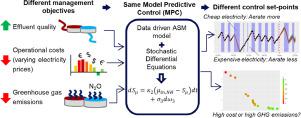Water Research ( IF 11.4 ) Pub Date : 2021-02-26 , DOI: 10.1016/j.watres.2021.116960 P.A. Stentoft , T. Munk-Nielsen , J.K. Møller , H. Madsen , B. Valverde-Pérez , P.S. Mikkelsen , L. Vezzaro

|
This study presents a general model predictive control (MPC) algorithm for optimizing wastewater aeration in Water Resource Recovery Facilities (WRRF) under different management objectives. The flexibility of the MPC is demonstrated by controlling a WRRF under four management objectives, aiming at minimizing: (A) effluent concentrations, (B) electricity consumption, (C) total operations costs (sum electricity costs and discharge effluent tax) or (D) global warming potential (direct and indirect nitrous oxide emissions, and indirect from electricity production) . The MPC is tested with data from the alternating WRRF in Nørre Snede (Denmark) and from the Danish electricity grid. Results showed how the four control objectives resulted in important differences in aeration patterns and in the concentration dynamics over a day. Controls B and C showed similarities when looking at total costs, while similarities in global warming potential for controls A and D suggest that improving effluent quality also reduced greenhouse gasses emissions. The MPC flexibility in handling different objectives is shown by using a combined objective function, optimizing both cost and greenhouse emissions. This shows the trade-off between the two objectives, enabling the calculation of marginal costs and thus allowing WRRF operators to carefully evaluate prioritization of management objectives. The long-term MPC performance is evaluated over 51 days covering seasonal and inter-weekly variations. On a daily basis, control A was 9–30% cheaper on average compared to controls A, D and to the current rule-based control. Similarly, control D resulted on average in 35–43% lower greenhouse gasses daily emission compared to the other controls. Difference between control performance increased for days with greater inter-diurnal variations in electricity price or greenhouse emissions from electricity production, i.e. when MPC has greater possibilities for exploiting input variations. The flexibility of the proposed MPC can easily accommodate for additional control objectives, allowing WRRF operators to quickly adapt the plant operation to new management objectives and to face new performance requirements.
中文翻译:

优先考虑废水质量,运营成本或全球变暖?–使用废水曝气的预测控制来灵活管理WRRF中的目标
这项研究提出了一种通用模型预测控制(MPC)算法,用于在不同管理目标下优化水资源回收设施(WRRF)中的废水曝气。通过在四个管理目标下控制WRRF来证明MPC的灵活性,该目标旨在最大程度地减少:(A)废水浓度,(B)耗电量,(C)总运营成本(总电费和排放废水税)或(D )全球变暖的潜力(直接和间接的一氧化二氮排放,以及电力生产的间接排放)。使用来自NørreSnede(丹麦)的交替WRRF和丹麦电网的数据对MPC进行了测试。结果表明,这四个控制目标如何导致一天中通气模式和浓度动态的重要差异。当查看总成本时,控件B和C表现出相似性,而控件A和D的全球变暖潜力相似性表明,污水质量的提高也减少了温室气体的排放。MPC在处理不同目标方面具有灵活性,这是通过使用组合的目标函数来实现的,从而优化了成本和温室气体排放。这显示了两个目标之间的权衡,可以计算边际成本,从而使WRRF运营商可以仔细评估管理目标的优先级。在51天内评估了MPC的长期性能,涵盖了季节性和每周间的变化。每天,与控件A,D和当前的基于规则的控件相比,控件A平均便宜9–30%。相似地,与其他对照相比,对照D导致的温室气体平均日排放量平均减少了35–43%。随着电价或发电产生的温室气体排放量的昼夜变化较大,即当MPC有更多利用输入变化的可能性时,控制性能之间的差异会增加几天。提议的MPC的灵活性可以轻松适应其他控制目标,从而使WRRF操作员可以使工厂操作快速适应新的管理目标并满足新的性能要求。当MPC具有更多利用输入变化的可能性时。提议的MPC的灵活性可以轻松适应其他控制目标,从而使WRRF操作员可以使工厂操作快速适应新的管理目标并满足新的性能要求。当MPC具有更多利用输入变化的可能性时。提议的MPC的灵活性可以轻松适应其他控制目标,从而使WRRF操作员可以使工厂操作快速适应新的管理目标并满足新的性能要求。











































 京公网安备 11010802027423号
京公网安备 11010802027423号